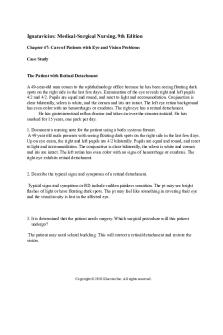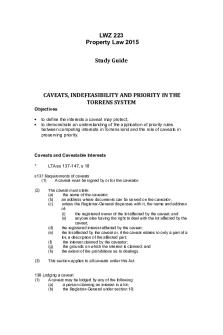Note 47 - study guide PDF

| Title | Note 47 - study guide |
|---|---|
| Author | Khoa Le |
| Course | Modern Music |
| Institution | University of Georgia |
| Pages | 6 |
| File Size | 55 KB |
| File Type | |
| Total Downloads | 102 |
| Total Views | 158 |
Summary
study guide...
Description
ABA, statement, contrast, return - Three part form can be represented as
Accelerando - Gradual speeding up of tempo
Accent - Stress or emphasis on a note
Adagio - Slow
Allegro - Fast
An interval - The distance in pitch between any two tones is called
Andante - Moderately slow; walking pace
Arpeggio - When the individual tones of a chord are sounded one after another, the result is a broken chord or
Beat - Organization of beats Into Regular groupings
Binary - Form consisting of a musical statement followed by a counterstatement would be called
By tightening or loosening the pegs - The strings of a violin are tuned by what
Chord - Combination of 3 or more tones at the same time
Consonance - A combination of tones that is considered stable and restful is called a
Contrabassoon - The lowest instrument in the orchestra is the
Counterpoint - The technique of combining several melodic lines into a meaningful whole
Crescendo - A gradual increase in loudness
Cycles per second - The frequency of vibrations is measured in
Dissonance - A combination of tones that is considered unstable and tense
Do not contain a string section - Symphonic bands differ from symphonic orchestras in that they
Dominant chord - Triad built on the fifth step of the scale
Downbeat - First, or stressed beat of the measure
Dynamics - Degrees of loudness and softness in music
Emphasizes a time by playing it more loudly than the tones around it - A dynamic accent occurs in music when a performer
Form - The organization of musical ideas in time is capled
Frequency - The pitch of a sound is decided by the ____ of its vibrations
Gradually decrease in loudness - The symbol > indicated to the performer the music should
Half step - In western music, the ____ is the smallest interval between successive tones of a scale
Harmonics - The very high-pitched tones that are produced when a string player lightly touched points on a string are called
Harmony - ____ in music adds support, depth, and richness to melody
Harmony - The way chords are constructed and how they follow each other
Higher - In general, the smaller the vibrating element, the ____ it's pitch
Homophonic - When there is one main melody accompanied by chords, the texture is
Horsehair - The bow which string players usually use to produce sound on their instruments is a slightly curved stick strung tightly with
Hymn, barbershop quartet, and unison - An example of homophonic texture could be
Imitation - When a melodic idea is presented by one voice or instrument and then restated by another voice or instrument, the technique is called
Key - A central tone, scale, and chord
Largo - Very slow
Measure - Unit or group containing a fixed number of beats
Meter - regular, recurrent pulsation that decides music into equal units of time
Metronome - Device that produces ticketing sounds or flashes of light any desired musical speed
Modulation - A shift from one key to another within the same composition is called
Molto - Much
Monophonic - The texture of a single melodic line without accompaniment is
Music - An art based on the organization of sounds in time
Mute - A hollow, funnel-shaped piece of wood or plastic that brass players use to alter their instruments is called
Non troppo - Not too much
Octave - When two different tones blend so well when sounded together that they almost seem to merge into one tone
Pianissimo, forte, fortissimo - The Italian dynamic markings used to indicate very soft, loud, and very loud
Piccolo - The highest woodwind instrument in the orchestra is the
Pitch - The relative highness or lowness of a sound is called
Pitch range - The distance between the lowest and highest tones that a voice or instrument can produce
Pizzicato - Plucking the string with the finger I stress of using a bow
Polyphonic - When two or more melodies of equal interest are performed simultaneously
Polyphonic texture - Contrapuntal texture is sometimes used in place of the term
Prestissimo - As fast as possible
Progression - A series of chords
Reed - A thin piece of cane, used single or in pairs by woodwind players
Register - a part of an instruments total range
Repitition - Creates unity, helps engrave a melody in the memory, and provides a feeling of balance and symmetry
Resolution - dissonant chord moving to a consonant chord
rhythm - Particular arrangement of note lengths in a piece of the ordered flow of music through time
Ritardando - Gradual slowing down of tempo
Singing requires control of breath, wider ranges of pitch and volume, vowel sounds - It is difficult to singe well because ____ than speaking
Strict imitation - A round is an example of
Syncopation - Putting an accent in music where it would not normally be expected
Synthesizers - Systems of electronic components which generate, modify, and control sound
tape studio - The main tool of composers of electronic music during the 1950's was the
Tempo - Rate of speed of the beat of music
The performer is nervous - If a string player uses vibrato-rocking of the left hand to produce small pitch fluctuations-it is because
Tonality - Key is another word
Tone - A sound that has a definite pitch
Tone color - Timbre is synonymous with
Tonic - The central key around which a musical composition is organized is called the
Tonic chord - A composition would almost always end on a
Training and physical makeup - The range of a singers voice depends upon
Unison - Performance of a single melodic line by more than one instrument or voice
Upbeat - Unaccented pulse preceding the downbeat
Variation - Retaining some features of a musical idea whole changing others
Vivace - Lively
Were originally made of wood - Woodwind instruments are so named Bc they...
Similar Free PDFs

Note 47 - study guide
- 6 Pages

Note 48 - study guide
- 4 Pages

Note 5 - study guide
- 6 Pages

Note 5 - study guide
- 6 Pages

Note 2 - study guide
- 7 Pages

Note 6 - study guide
- 7 Pages

Note 9 - study guide
- 7 Pages

Note 3 - study guide
- 5 Pages

Note 46 - study guide
- 6 Pages

Note 14 - study guide
- 4 Pages

Note 5 - Study Guide
- 18 Pages
Popular Institutions
- Tinajero National High School - Annex
- Politeknik Caltex Riau
- Yokohama City University
- SGT University
- University of Al-Qadisiyah
- Divine Word College of Vigan
- Techniek College Rotterdam
- Universidade de Santiago
- Universiti Teknologi MARA Cawangan Johor Kampus Pasir Gudang
- Poltekkes Kemenkes Yogyakarta
- Baguio City National High School
- Colegio san marcos
- preparatoria uno
- Centro de Bachillerato Tecnológico Industrial y de Servicios No. 107
- Dalian Maritime University
- Quang Trung Secondary School
- Colegio Tecnológico en Informática
- Corporación Regional de Educación Superior
- Grupo CEDVA
- Dar Al Uloom University
- Centro de Estudios Preuniversitarios de la Universidad Nacional de Ingeniería
- 上智大学
- Aakash International School, Nuna Majara
- San Felipe Neri Catholic School
- Kang Chiao International School - New Taipei City
- Misamis Occidental National High School
- Institución Educativa Escuela Normal Juan Ladrilleros
- Kolehiyo ng Pantukan
- Batanes State College
- Instituto Continental
- Sekolah Menengah Kejuruan Kesehatan Kaltara (Tarakan)
- Colegio de La Inmaculada Concepcion - Cebu




